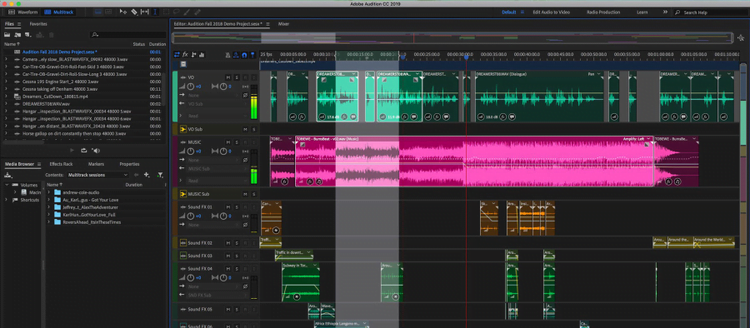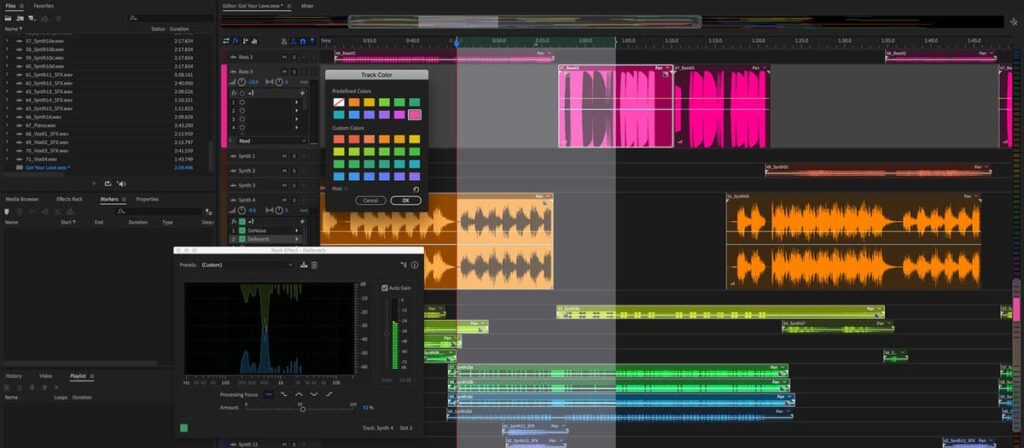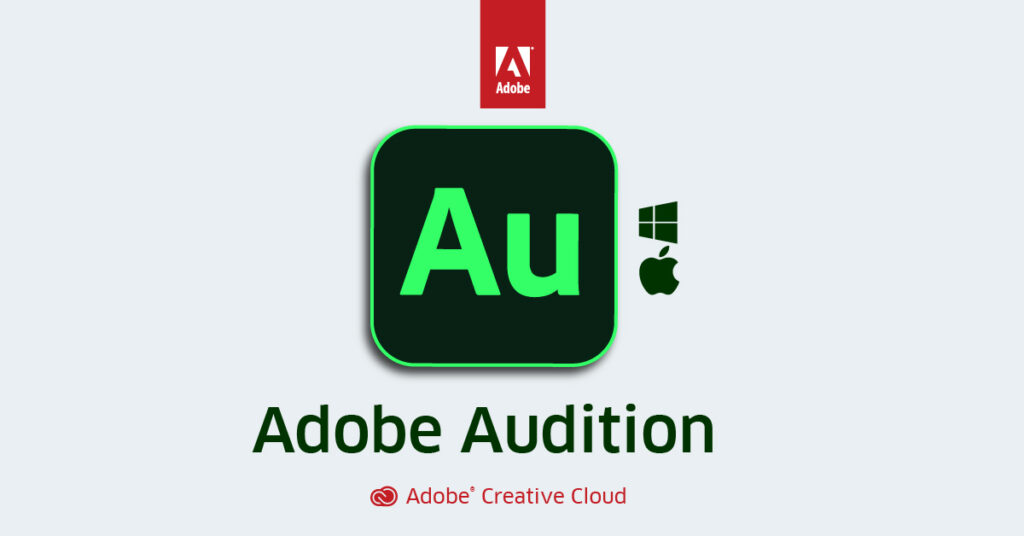Discover Adobe Audition’s history, evolution, powerful features, and diverse uses in professional audio editing, sound design, and music production.
Adobe Audition: The Complete Educational Guide to Its History, Usage, and Features
When it comes to professional audio editing, restoration, and sound design, Adobe Audition stands at the forefront. Known for its precision, versatility, and seamless integration with Adobe Creative Cloud, it has become an essential tool for audio engineers, podcasters, video editors, and musicians worldwide.
In this in-depth educational guide, we’ll explore the history, features, and practical uses of Adobe Audition, detailing how it evolved into one of the most powerful digital audio workstations (DAWs) in the creative industry.
Click here to Download Adobe Audition Versions
1. The History of Adobe Audition
1.1 Early Beginnings as Cool Edit

Before it became Adobe Audition, the software was known as Cool Edit — an audio editing program developed by Syntrillium Software in the early 1990s. Cool Edit began as a simple shareware application for Windows, offering basic waveform editing and effects processing.
It quickly gained popularity among home studios and radio professionals for its intuitive interface and high-quality sound processing capabilities. By 1997, Syntrillium released Cool Edit Pro, which introduced multitrack editing — a groundbreaking feature that allowed users to record and mix multiple audio tracks simultaneously.
Cool Edit Pro became a go-to solution for semi-professional users and small studios, bridging the gap between consumer and professional audio software.
1.2 Adobe’s Acquisition and the Birth of Adobe Audition
Recognizing the potential of Cool Edit, Adobe Systems acquired Syntrillium Software and its technology in May 2003. Shortly after the acquisition, Adobe rebranded Cool Edit Pro as Adobe Audition 1.0.
This marked the beginning of Audition’s evolution into a full-fledged professional digital audio workstation integrated within Adobe’s suite of creative tools.
Adobe Audition 1.0 (2003) retained the familiar interface of Cool Edit Pro but included enhanced performance, refined effects, and tighter integration with other Adobe applications like Premiere Pro — a key feature that continues to define the software today.
1.3 Evolution Through the Years
Over the years, Adobe Audition has undergone significant transformation. Below is a timeline of major releases and milestones:
- Audition 1.0 (2003): First release under Adobe; improved interface and stability.
- Audition 2.0 (2006): Introduced a new audio engine, VST support, and enhanced mixing tools.
- Audition 3.0 (2007): Added Spectral Frequency Display, Guitar Suite effects, and better workflow tools.
- Audition CS5.5 (2011): Complete rebuild for 64-bit architecture; integrated seamlessly with Adobe Premiere Pro.
- Audition CS6 (2012): Introduced powerful new features like Automatic Speech Alignment and expanded multitrack capabilities.
- Audition CC (2013): Transitioned to Adobe Creative Cloud, offering cloud storage, regular updates, and cross-platform compatibility (Windows and macOS).
- Audition CC 2015–2020: Enhanced editing tools, real-time clip stretching, and improved multitrack workflow.
- Audition 2021 and beyond: Introduced AI-powered tools, loudness metering, and improved integration with Adobe’s video suite.

Today, Adobe Audition remains one of the most respected tools for professional audio production, widely used in broadcasting, film, television, and podcasting.
2. Understanding Adobe Audition
2.1 What Is Adobe Audition?
Adobe Audition is a digital audio workstation (DAW) that enables users to record, edit, mix, and restore sound. It’s designed for professional audio production, offering tools for precise waveform editing, multitrack mixing, spectral analysis, and audio restoration.
Unlike music production DAWs like Ableton Live or FL Studio, Audition focuses more on post-production, broadcast editing, and audio restoration — though it can still be used for composing and recording music.
2.2 The Core Philosophy
Adobe Audition emphasizes three key pillars:
- Precision Editing – Non-destructive multitrack workflows and high-resolution waveform editing.
- Restoration and Repair – Tools for cleaning up noisy or distorted audio.
- Integration and Efficiency – Seamless collaboration with Adobe Premiere Pro and other Creative Cloud applications.
This balance of flexibility and professional-grade accuracy makes Audition a top choice for industries where sound quality and reliability are paramount.
3. The Main Uses of Adobe Audition
3.1 Audio Editing and Restoration
One of Adobe Audition’s strongest applications is audio editing. Users can cut, copy, paste, and rearrange audio clips with sample-level precision. The Spectral Frequency Display visualizes sound in color, making it easier to identify and remove unwanted noises such as hisses, hums, or clicks.
Audio engineers can restore old or damaged recordings using Noise Reduction, DeReverb, and DeClicker tools. This makes it invaluable in fields like archival audio restoration, film post-production, and podcast mastering.
3.2 Multitrack Mixing and Mastering
Audition’s Multitrack Editor allows users to combine multiple audio clips, add effects, automate volume levels, and produce polished mixes.
It supports an extensive range of audio formats, multichannel recording, and real-time effect application. Users can apply bus tracks, aux sends, and submixes to control large projects efficiently.
The Essential Sound Panel simplifies audio mixing by providing preset adjustments for dialogue, music, ambiance, and sound effects — ideal for beginners and professionals alike.
3.3 Podcast Production
Podcasting has become one of the fastest-growing media formats, and Adobe Audition is a favorite among podcasters for its clean workflow.
It provides tools for recording, editing, leveling voices, reducing background noise, and exporting to standard podcast formats. Adobe also includes automatic loudness correction, ensuring that episodes meet industry loudness standards like ITU-R BS.1770.
The Podcast Production Template simplifies the setup process, helping creators get professional-quality audio without needing deep technical knowledge.
3.4 Film and Video Post-Production
Audition’s seamless integration with Adobe Premiere Pro makes it indispensable in film and video production. Editors can easily send entire sequences from Premiere Pro to Audition for advanced sound mixing and restoration.
This workflow — often called Dynamic Link — eliminates the need to export intermediate files manually. Changes made in Audition reflect automatically in the video project, saving time and reducing errors.
In post-production, Audition is used for:
- Dialogue editing and noise cleanup
- Foley and sound design
- ADR (Automatic Dialogue Replacement)
- Final mixing and mastering
3.5 Sound Design and Foley Work
For sound designers, Audition offers the ability to create and manipulate audio textures using time stretching, pitch shifting, and real-time effects. Foley artists can record custom sounds and blend them with ambient audio, all within one environment.
The Spectral Editing tools allow users to isolate and transform specific sound frequencies, opening creative possibilities for special effects and cinematic soundscapes.
4. Core Features of Adobe Audition
Adobe Audition is packed with advanced tools that cater to professionals while remaining accessible to beginners. Here’s a detailed breakdown of its most powerful features.
4.1 Waveform Editor
The Waveform Editor is Audition’s single-track editing view. It’s designed for precise audio repair, trimming, and mastering. Users can visualize audio waves, zoom into specific frequencies, and apply real-time effects.
Key features include:
- Non-destructive editing
- Spectral Frequency Display
- Real-time effects and preview
- Clip-level gain and normalization
This view is ideal for cleaning up individual recordings or preparing sound effects.
4.2 Multitrack Editor
The Multitrack Editor enables recording, mixing, and layering multiple audio tracks simultaneously. It supports up to hundreds of tracks depending on your hardware and allows non-destructive editing for maximum flexibility.
Users can:
- Apply effects to individual tracks or entire mixes
- Automate volume, panning, and effect parameters
- Group clips for batch editing
- Synchronize audio with video from Premiere Pro
This mode is the heart of professional audio mixing in Audition.
4.3 Spectral Frequency Display
One of Adobe Audition’s most iconic tools, the Spectral Frequency Display, shows audio as a color-coded visualization of frequency and amplitude. This lets users identify and edit specific sounds — like removing a cough from a voice recording without affecting the surrounding audio.
Spectral editing is invaluable for forensic audio work, restoration, and creative sound design.
4.4 Essential Sound Panel
The Essential Sound Panel simplifies complex mixing tasks with intuitive, preset-based controls. You can tag clips as Dialogue, Music, Sound Effects, or Ambience, and Audition automatically provides optimized settings for each.
This feature is perfect for content creators, video editors, and podcasters who need professional audio results without deep technical knowledge.
4.5 Audio Effects and Plug-ins
Audition includes an extensive collection of audio effects, including:
- Reverb and Echo
- Equalizers (Parametric and Graphic EQ)
- Compressors and Limiters
- Noise Reduction
- Pitch Shifting and Time Stretching
Additionally, Audition supports VST (Virtual Studio Technology) and AU (Audio Unit) plug-ins, allowing users to expand their toolkit with third-party effects and virtual instruments.
4.6 Noise Reduction and Restoration Tools
Audition is a leader in audio restoration, offering tools to remove unwanted noise, hum, clicks, and distortions.
Features like Adaptive Noise Reduction, DeHummer, and DeClicker use intelligent algorithms to clean recordings while preserving audio quality.
This makes it indispensable for archival work, podcast editing, and film post-production.
4.7 Automatic Speech Alignment
This feature is invaluable in film production and dubbing. It automatically aligns dialogue takes with the original performance, saving hours of manual syncing.
By analyzing timing and pitch, Audition matches alternate takes or ADR recordings seamlessly to the video.
4.8 Loudness Metering and Mixing
To ensure consistent volume across different media formats, Audition includes Loudness Metering that complies with industry standards such as EBU R128 and ITU BS.1770.
This is crucial for broadcast and streaming platforms that require specific loudness levels for audio content.
4.9 Batch Processing and Automation
For repetitive tasks, Audition allows batch processing — automating effects or file conversions for multiple files simultaneously.
Users can create Favorites (custom macro commands) and apply them to entire folders of audio clips, streamlining large-scale projects.
4.10 Integration with Adobe Creative Cloud
Adobe Audition’s tight integration with Creative Cloud allows users to collaborate across apps like:
- Premiere Pro for video editing
- After Effects for motion graphics
- Media Encoder for exporting
Cloud syncing ensures projects, settings, and effects are available across devices, enhancing collaboration for remote teams and production studios.
5. The Role of Adobe Audition in Modern Media
5.1 In Broadcasting
Audition is a standard tool in radio and television studios worldwide. Broadcasters rely on its speed, stability, and precise waveform editing for producing commercials, news segments, and shows.
Its real-time metering and support for multiple audio formats make it perfect for maintaining broadcast-quality sound.
5.2 In Podcasting and Online Media
With the rise of podcasting and YouTube, Adobe Audition has become the preferred choice for content creators. Its streamlined interface and templates make it easy to record, edit, and publish audio content professionally.
The ability to mix, normalize, and master episodes ensures consistent sound quality across all platforms.
5.3 In Film and Game Sound Design
In the film industry, Audition plays a critical role in sound design and post-production. Its spectral editing tools and synchronization with Premiere Pro make it perfect for creating immersive soundscapes and foley work.
Game developers also use Audition for creating ambient sound effects, dialogue editing, and environmental audio layers.
6. Learning Adobe Audition
While powerful, Adobe Audition is designed with accessibility in mind. Beginners can start with simple recording and trimming, while professionals can dive into detailed multitrack editing and mastering.
Common learning paths include:
- Recording and editing voiceovers
- Using spectral tools for restoration
- Mixing and applying effects
- Exporting for broadcast and streaming
Its Essential Sound Panel provides an intuitive gateway to understanding professional sound workflows.
7. The Future of Adobe Audition
Adobe continues to evolve Audition with AI-assisted editing, machine learning-based restoration, and deeper Creative Cloud integration.
Future updates are expected to include more automated workflows, improved collaboration tools, and enhanced cloud storage — allowing professionals to edit anywhere, anytime.
As audio production expands into immersive experiences like 3D audio and virtual reality, Adobe Audition is poised to adapt and lead in these new frontiers.
From its humble beginnings as Cool Edit Pro to becoming a cornerstone of the Adobe Creative Cloud, Adobe Audition has transformed how professionals edit, mix, and produce sound.
Its combination of precision editing, intelligent restoration tools, and seamless integration with video and design software makes it an indispensable tool across industries.
Whether you’re a podcaster, sound designer, musician, or film editor, Adobe Audition empowers you to achieve clean, professional, and emotionally engaging audio.
In the world of sound production, Adobe Audition doesn’t just edit audio — it brings sound to life.

Download Adobe Audition 2020 13.0.3.60 (x64) Patched Windows
Download Adobe Audition 2020 v13.0.10 Pre-Cracked (macOS)
You May also Download: Adobe Photoshop 2020 for Windows & Mac Os
You May also Download: Adobe Illustrator CC 2020 for Windows & Mac Os
You May also Download: Windows 10 Pro x64 2023
Support Kanel Technologies Africa
Your generosity keeps Kanel Technologies Africa alive and accessible to everyone. Every contribution—no matter the size—helps us maintain our website, create meaningful content, and expand our mission of empowering communities through technology and innovation.
Your support sustains our digital tools, learning resources, and outreach programs that bring opportunity and knowledge to people across Africa.
No amount is too small—each donation strengthens our ability to connect, inspire, and make lasting impact. Together, we can build a brighter, more connected future for Africa through the power of technology.
Thank you for believing in our vision and helping us grow.

